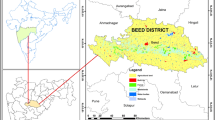Abstract
Rice areas in India are being mapped for acreage estimation using Synthetic Aperture Radar (SAR) data under forecasting agricultural output using space, agrometeorology and land-based observations (FASAL) program for over a decade now. Under this study, an attempt was made to segregate rice areas based on variety in parts of Punjab state. Data acquisition was done at critical stages of rice growth. The shift in transplantation in temporal domain and difference in canopy volume formed the basis of characterization of rice crop into two different varieties namely aromatic and non-aromatic. Multitemporal HH polarization data along with rate of change of cross polarization ratio (HH/HV) from July to September 2011 was used. The aromatic rice could be separated from normal rice with 91% accuracy.






Similar content being viewed by others
References
Ban Y and Howarth P J 1999 Multitemporal ERS-1 SAR data for crop classification: A sequential masking approach; Can. J. Remote Sens. 25 438– 447.
Chakraborty M, Panigrahy S, and Sharma S A 1997 Discrimination of rice crop grown under different cultural practices using temporal ERS1 SAR data; ISPRS Photogramm. Remote Sens. 52 183–191.
De Dutta S K 1981 Principles and Practices of Rice Cultivation; Wiley-Interscience, New York, 618p.
Huke R E 1982 Rice Area by Type of Cultural: South, South East and East Asia; International Rice Research Institute, Las Banos, Philippines, 42p.
Moran M S, Vidal A, Troufleau D, Inoue Y and Mitchell T A 1998 Ku- and C-band SAR for discriminating agricultural crop and soil conditions; IEEE Trans. Geosci. Remote Sens. 36 265–272.
Prevot L, Dechambre M, Taconet O, Vidal-Madjar D, Normand M, and Galle S 1993 Estimating the characteristics of vegetation canopies with airborne radar measurements; Int. J. Remote Sens. 14 2803–2818.
Saich P and Borgeaud M 2000 Interpreting ERS SAR signatures of agricultural crops in Flevoland 1993–1996; IEEE Trans. Geosci. Remote Sens. 38 651–657.
Skriver H, Svendsen M T, and Thomsen A G 1999 Multitemporal C- and L-band polarimetric signatures of crops; IEEE Trans. Geosci. Remote Sens. 37 2413–2429. http://zpdzone1.org/zone1/download.php?file=Amritsar8780.doc.
Acknowledgements
Authors are thankful to Dr M Chakraborty, Group Director, ATDG/SAC for his technical guidance. The Radarsat data used in this study is due to courtesy of the national project, FASAL.
Author information
Authors and Affiliations
Corresponding author
Rights and permissions
About this article
Cite this article
Jain, V., Patnaik, C. & Panigrahy, S. A feasibility study on identification of Basmati (aromatic) rice using SAR data. J Earth Syst Sci 123, 1831–1838 (2014). https://doi.org/10.1007/s12040-014-0508-y
Received:
Revised:
Accepted:
Published:
Issue Date:
DOI: https://doi.org/10.1007/s12040-014-0508-y




